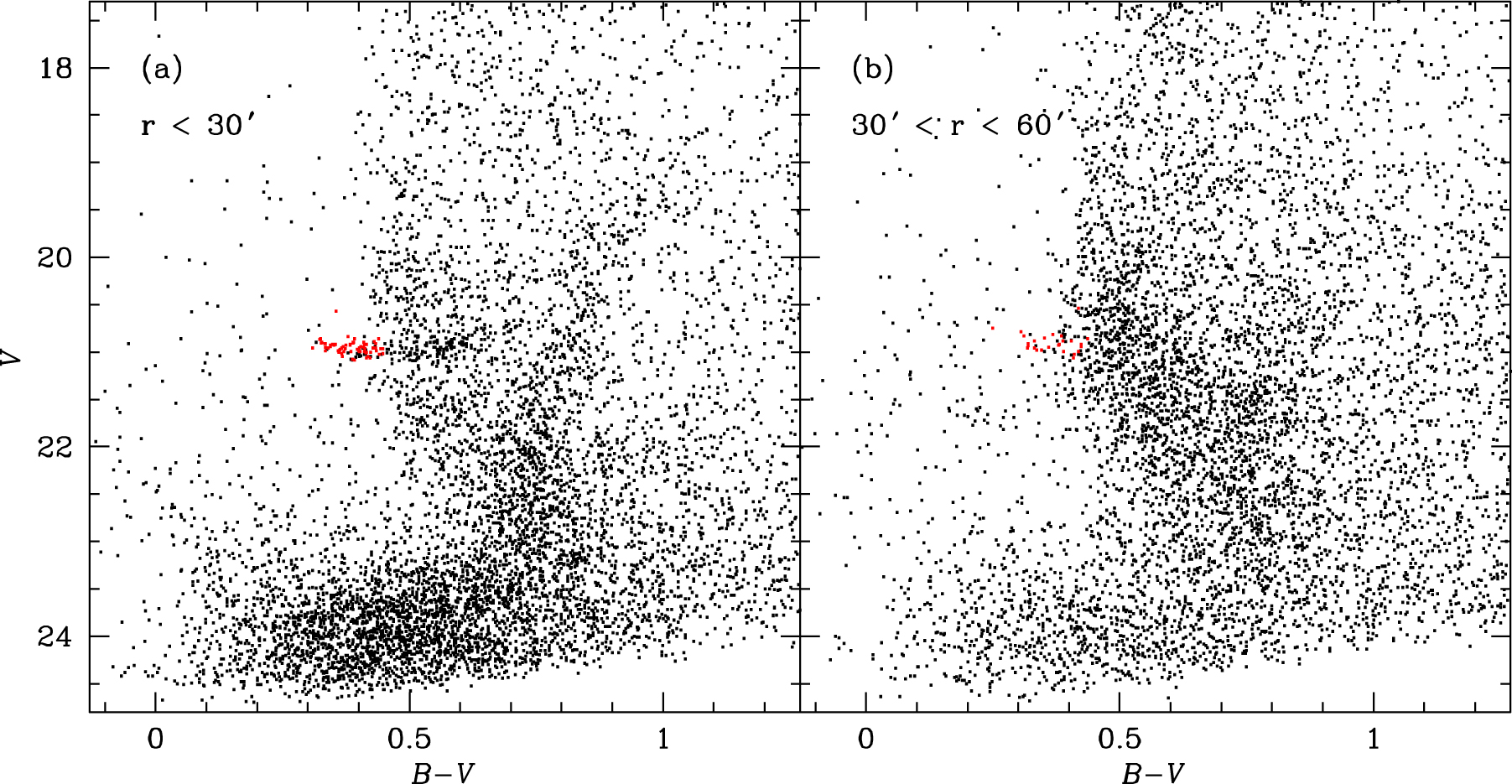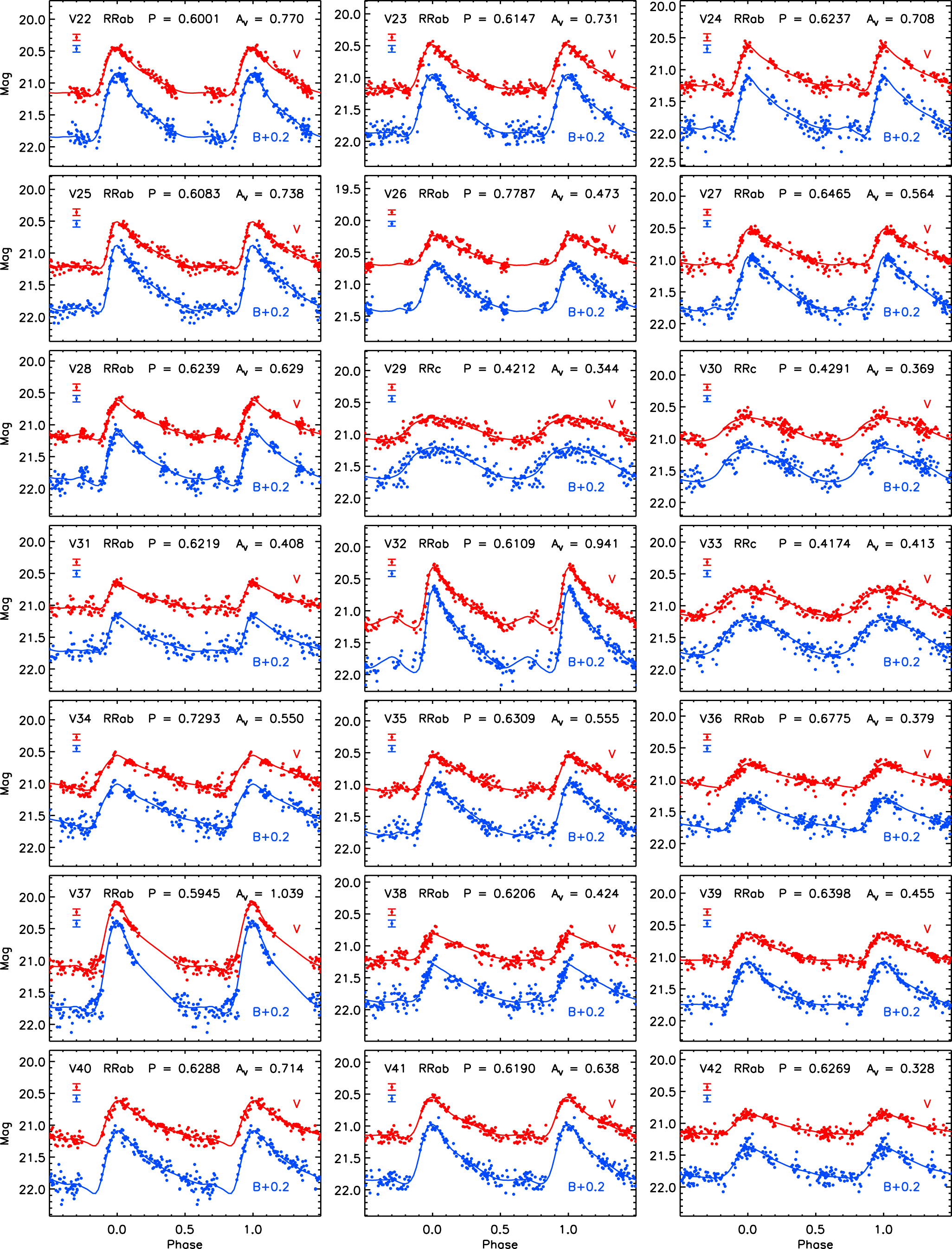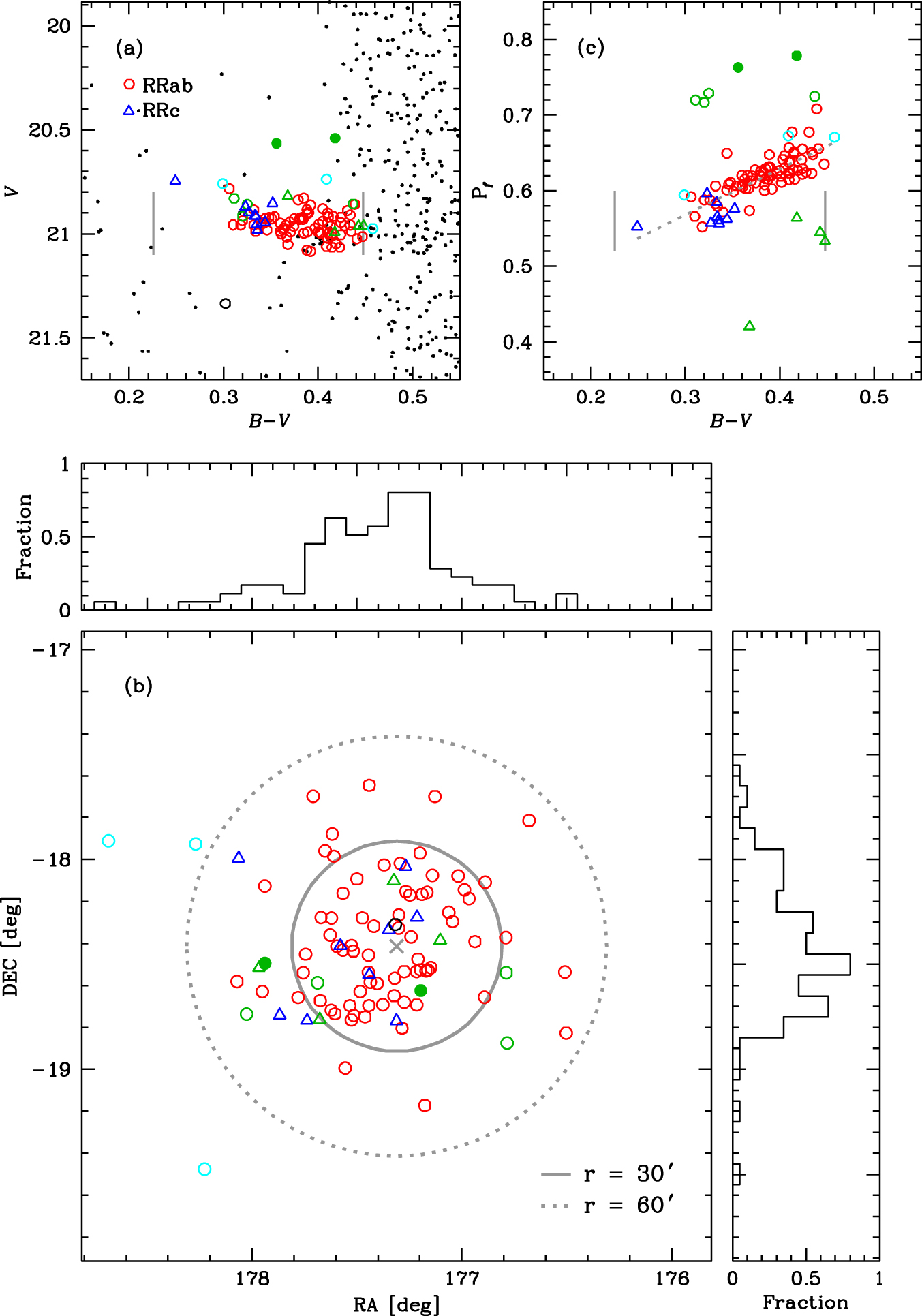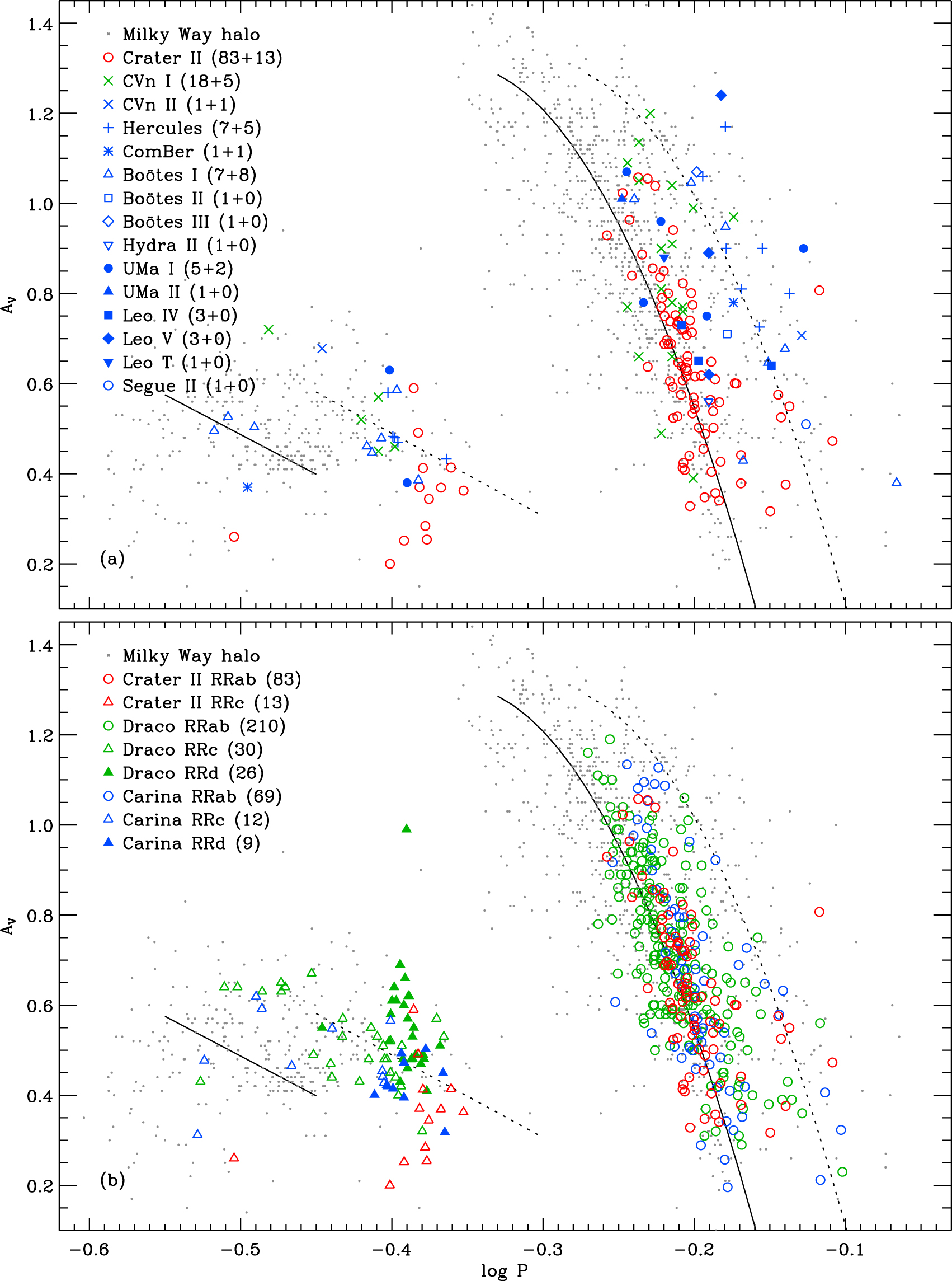RR Lyrae Variables in the Crater II Dwarf Galaxy
* The paper (Joo et al. 2018, ApJ, 861, 23) is summarized as following:
The Crater II dwarf galaxy is one of the most recently discovered MW satellites in the southern hemisphere, first reported by Torrealba et al. (2016) using the VST ATLAS survey data. From the total luminosity of MV ~ -8.2, Crater II can be classified as either one of the brightest UFDs or one of the faintest classical dwarf spheroidal (dSph) galaxies. Interestingly, given the total luminosity, this galaxy is very large (half-light radius, rh ~ 1066 pc) and diffuse (V ~ 30.6 mag arcsec^-2). It is currently the fourth largest MW satellite only the Large Magellanic Cloud (LMC), the Small Magellanic Cloud (SMC), and the Sagittarius (Sgr) dwarf galaxy are larger and one of the lowest surface brightness galaxies known (Torrealba et al. 2016).
We investigate the RR Lyrae population in the Crater II dwarf galaxy based on time-series observations. Time-series B, V observations of the Crater II dwarf galaxy were carried out using the KMTNet-CTIO 1.6 m telescope during 2016 February 1-4, 6-10, and 2017 January 29-30 (UT). Our observations covered a total area of ~3 x 3 degree^2 with five largely overlapping fields, which is more than twice the half-light radius of the galaxy (rh ~ 31', Torrealba et al. 2016). With an exposure time of 120 s per image, we obtained in total 143 and 145 frames in the B- and V-bands, respectively, which correspond to a total exposure time of ~4.8 hr in each passband.
Figure 1 show the CMDs of stars within and outside the half-light radius (rh ~ 31') of Crater II, produced by performing PSF photometry on the combined images of all our time-series data. In panel (a), for stars within the half-light radius, we can clearly see the CMD features of Crater II, such as the RGB, red HB, sub-giant branch (SGB), and even main-sequence turn-off (MSTO). Panel (b), for stars outside the half-light radius, however, shows only weak features of Crater II superimposed on the background contamination, indicating that most member stars are within the half-light radius.

To identify and characterize RR Lyrae stars in the field of Crater II, we applied the template light curve fitting routine, RRFIT, developed by Yang & Sarajedini (2012). By visually inspecting the output light curves from RRFIT, we finally identified 96 RR Lyrae stars, including 83 fundamental mode (ab-type) and 13 first overtone (c-type) pulsators. Figure 2 presents the light curves and the best-fitting templates for all the detected RR Lyrae stars.





The panels in Figure 3 present the CMD, spatial distribution, and color-period diagram of the RR Lyrae stars we have detected in Crater II. Panel (a) also shows that the RR Lyrae stars gather on the red side of the instability strip in their color distribution. This further indicates that Crater II has a red HB morphology with virtually no blue HB stars. Panel (b) illustrates that the RR Lyrae stars are clustered around the galaxy's center estimated by Torrealba et al. (2016). About 70% (67 out of 96) of RR Lyrae stars are within 30' (approximately the half-light radius), and about 97% (93 out of 96) of them are within 60' from the center. The CMD and spatial distribution of the RR Lyrae variables in panels (a) and (b) thus strongly suggest that most of them belong to Crater II.

RR Lyrae stars can further be used to estimate metallicity, reddening, and distance of a stellar system independently of other methods, since their pulsation properties (including period and amplitude) are correlated with the stellar evolution parameters such as mass, metallicity, temperature, and luminosity. To obtain metallicities for the individual RRab stars of Crater II, we used the empirical period-amplitude?metallicity relation derived by Alcock et al. (2000). That gives the mean metallicity, [Fe H] = -1.65 +- 0.15. Independent estimation for the interstellar reddening can be made using the B-band amplitude (AB), metallicity, and period of RRab stars, namely, the amplitude - color -metallicity and/or period-amplitude - color - metallicity relations derived by Piersimoni et al. (2002). This method gives E(B-V)=0.05+-0.02. Combining the relation by Chaboyer(1999) with the derived reddening value, the mean apparent V-magnitude, <V_RR> = 20.95 +- 0.01, [Fe/H]=-1.65, we finally obtain a distance modulus of (m-M)_0 = 20.25 +- 0.10 and a distance of de = 112 +- 5 kpc to Crater II.
Most RR Lyrae stars in the UFDs studied so far are classified as Oo-int or Oosterhoff II (OoII) (e.g., Clementini 2014; Vivas et al. 2016, and references therein). Hence, a reliable Oosterhoff classification of Crater II based on the mean period of RRab stars and the Bailey diagram would help to understand the properties of its stellar population. In Figure 4, we compare the RR Lyrae stars in Crater II with those in the Galactic halo field (data from Zinn et al. 2014), the other 14 UFDs (top panel), and the two classical dSphs, Draco and Carina (bottom panel), on the period-amplitude diagrams. Crater II and CVn I, are clearly distinct from the other UFDs, but rather similar to the two classical dSphs with Oo-int properties. This also leads us to conclude that Crater II is more like a classical dSph rather than a UFD.

A lack of the HASP(High Amplitude Short Period) RRab stars and relatively low stellar mass, Crater II also may not be directly related to the MW building blocks. Given its size and surface brightness, however, the presence of Crater II itself implies that there might be even larger galaxies yet to be discovered, under the current surface brightness detection limit, as possible massive (and therefore metal-rich) remnants of the building blocks.
References
- Alcock, C., Allsman, R. A., Alves, D. R., et al. 2000, AJ, 119, 2194
- Cacciari, C., & Clementini, G. 2003, in Stellar Candles for the Extragalactic
- Distance Scale, Vol. 635, ed. D. Alloin & W. Gieren (Berlin: Springer), 105
- Chaboyer, B. 1999, in Post-Hipparcos Cosmic Candles, Vol. 237 ed. A. Heck & F. Caputo (Dordrecht: Kluwer), 111
- Clement, C. M., Muzzin, A., Dufton, Q., et al. 2001, AJ, 122, 2587
- Clementini, G. 2014, in Proc. IAU Symp. 301, Precision Asteroseismology, ed. J. A. Guzik et al. (Cambridge: Cambridge Univ. Press), 129
- Nemec, J. M. 1985, AJ, 90, 204
- Joo, S.-J., Kyeong, J., Yang, S.-C., et al. 2018, ApJ, 861, 23
- Piersimoni, A. M., Bono, G., & Ripepi, V. 2002, AJ, 124, 1528
- Torrealba, G., Koposov, S. E., Belokurov, V., & Irwin, M. 2016, MNRAS, 459, 2370
- Vivas, A. K., Olsen, K., Blum, R., et al. 2016, AJ, 151, 118
- Walker, A. R. 1998, AJ, 116, 220
- Yang, S.-C., & Sarajedini, A. 2012, MNRAS, 419, 1362
- Zinn, R., Horowitz, B., Vivas, A. K., et al. 2014, ApJ, 781, 22
- Zorotovic, M., Catelan, M., Smith, H. A., et al. 2010, AJ, 139, 357
Downloadable files: light curve text files and their plots.
* If you have questions, please contact Dr. Seok-Joo Joo ( sjjoo250@gmail.com)
* The use of the downloaded data from this website requires the following acknowledgment : "The data is acquired from the KASI (Korea Astronomy & Space Science Institute) archive."